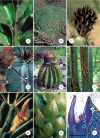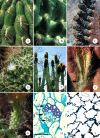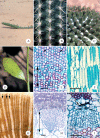Structure-function relationships in highly modified shoots of cactaceae
- PMID: 16820405
- PMCID: PMC2803597
- DOI: 10.1093/aob/mcl133
Structure-function relationships in highly modified shoots of cactaceae
Abstract
Background and aims: Cacti are extremely diverse structurally and ecologically, and so modified as to be intimidating to many biologists. Yet all have the same organization as most dicots, none differs fundamentally from Arabidopsis or other model plants. This review explains cactus shoot structure, discusses relationships between structure, ecology, development and evolution, and indicates areas where research on cacti is necessary to test general theories of morphogenesis.
Scope: Cactus leaves are diverse; all cacti have foliage leaves; many intermediate stages in evolutionary reduction of leaves are still present; floral shoots often have large, complex leaves whereas vegetative shoots have microscopic leaves. Spines are modified bud scales, some secrete sugar as extra-floral nectaries. Many cacti have juvenile/adult phases in which the flowering adult phase (a cephalium) differs greatly from the juvenile; in some, one side of a shoot becomes adult, all other sides continue to grow as the juvenile phase. Flowers are inverted: the exterior of a cactus 'flower' is a hollow vegetative shoot with internodes, nodes, leaves and spines, whereas floral organs occur inside, with petals physically above stamens. Many cacti have cortical bundles vascularizing the cortex, however broad it evolves to be, thus keeping surface tissues alive. Great width results in great weight of weak parenchymatous shoots, correlated with reduced branching. Reduced numbers of shoot apices is compensated by great increases in number of meristematic cells within individual SAMs. Ribs and tubercles allow shoots to swell without tearing during wet seasons. Shoot epidermis and cortex cells live and function for decades then convert to cork cambium. Many modifications permit water storage within cactus wood itself, adjacent to vessels.
Figures



References
-
- Anderson EF. (2001) The cactus family(Timber Press, Portland, OR).
-
- Arias S, Terrazas T, Cameron K. (2003) Phylogenetic analysis of Pachycereus (Cactaceae, Pachycereeae) based on chloroplast and nuclear DNA sequences. Systematic Botany 28547–557.
-
- Arias Montes AS. (1996) Revisión taxonómica del género Pereskiopsis Britton et Rose (Cactaceae). (Universidad Nacional Autónoma de México, Mexico).
-
- Arnold DH and Mauseth JD. (1999) Effects of environmental factors on development of wood. American Journal of Botany 86367–371. - PubMed
-
- Backeberg C. (1958) Die Cactaceae. Handbuch der Kakteenkunde. I. Einleitung und Beschreibung der Peireskioideae und Opuntioideae(VEB Gustav Fisher Verlag, Jena).

